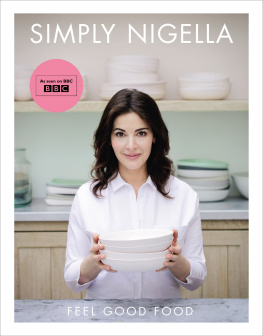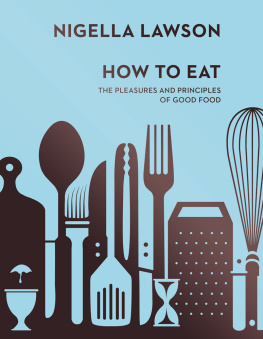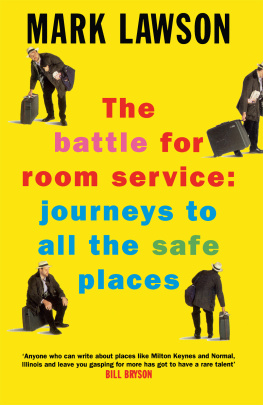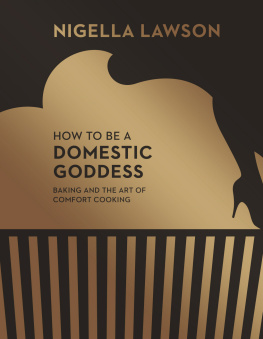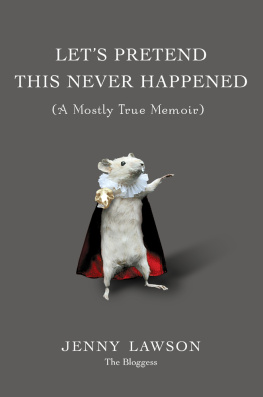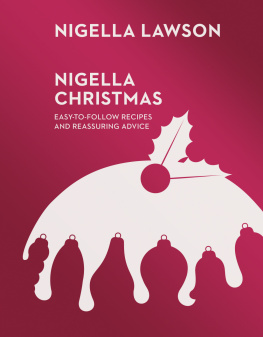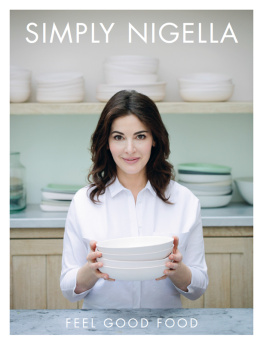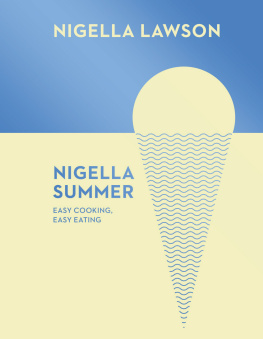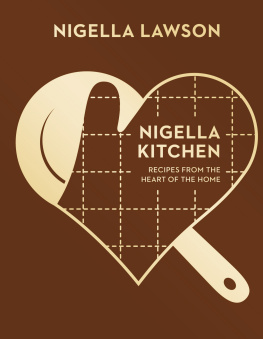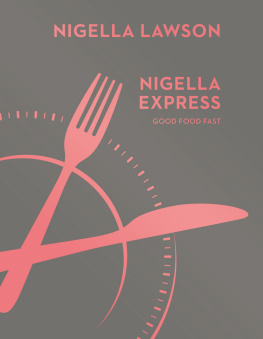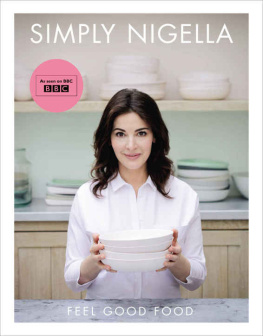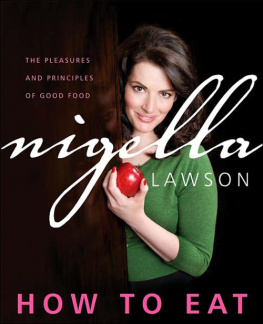CONTENTS
ABOUT THE AUTHOR
Nigella Lawson has written nine bestselling cookery books, including the classics How To Eat and How To Be a Domestic Goddess the book that launched a thousand cupcakes. These books, her TV series and her Quick Collection app, have made her a household name around the world. In 2014 she was voted Best Food Personality in a readers poll at the Observer Food Monthly Awards.
www.nigella.com
@Nigella_Lawson
ABOUT THE BOOK
Part of the balance of life lies in understanding that different days require different ways of eating
Whatever the occasion, food in the making and the eating should always be pleasurable. Simply Nigella taps into the rhythms of our cooking lives, with recipes that are uncomplicated, relaxed and yet always satisfying
From quick and calm suppers (Miso Salmon, Cauliflower & Cashew Nut Curry) to stress-free ideas when catering for a crowd (Chicken Traybake with Bitter Orange & Fennel), or the instant joy of bowlfood for cosy nights on the sofa (Thai Noodles with Cinnamon and Prawns), here is food guaranteed to make everyone feel good.
Whether you need to create some breathing space at the end of a long week (Asian-Flavoured Short Ribs), indulge in a sweet treat (Lemon Pavlova, Chocolate Chip Cookie Dough Pots) or wake up to a strength-giving breakfast (Toasty Olive Oil Granola), Nigellas new cookbook is filled with recipes destined to become firm favourites.
Simply Nigella is the perfect antidote to our busy lives: a calm and glad celebration of food to soothe and uplift.
For Mimi and Bruno
INTRODUCTION
It is a commonplace to talk of cooking as being therapeutic and there are times when that is the case but for me cooking stems from an engagement with life, which in itself combines hopefulness with playfulness. These gifts restored to me, this book began to emerge.
Of course, even when I felt I couldnt cook, or didnt have a kitchen of my own, I still needed to bring food to the table, and I am grateful for this. If cooking isnt hinged on necessity, it loses its context, and purpose. I cook to give pleasure, to myself and others, but first it is about sustaining life, and only then about forging a life.
We make worlds for ourselves all the time; for me, the locus has always been the kitchen. And while there have been times in my life when cooking has created a safe place, and a vital space where I could lose myself in creative concentration, all of which have been documented in my previous books, with this book it has been different. I first had to cook myself strong. Now, you will never hear me talking about healthy food. I loathe the term, but not as much as I am disgusted by the contemporary mantra of clean eating. In How To Eat, written so long ago, I wrote: What I hate is the new-age voodoo about eating, the notion that foods are either harmful or healing, that a good diet makes a good person and that that person is necessarily lean, limber, toned and fit Such a view seems to me in danger of fusing Nazism (with its ideological cult of physical perfection) and Puritanism (with its horror of the flesh and belief in salvation through denial).
The Clean-Eating brigade seems an embodiment of all my fears. Food is not dirty, the pleasures of the flesh are essential to life and, however we eat, we are not guaranteed immortality or immunity from loss. We cannot control life by controlling what we eat. But how we cook and, indeed, how we eat does give us as much as anything can mastery over ourselves.
The food in this book is what Ive been cooking for myself and, although the impetus was certainly to seek out food that made me feel physically strong, I have always believed that food you cook for yourself is essentially good for you. This is not just because real ingredients are better for you than fake foods, but because the act of cooking for yourself is in itself a supremely positive act, an act of kindness. And while I have read much about mindful eating, I have not found much, if anything, on mindful cooking. When I cook, I am absorbed in the simple rituals of chopping, stirring, tasting, losing myself in the world of flavour, sensation and straightforward practicalities.
And as I progressed, this book became fused with the joyful realities of making a new home. It makes me smile to see the colours of my kitchen, and the house I have created around myself, reflected in the colours of this book. But, of course, it also necessarily tells the broader story of how I live: how I feed my friends and family, the aesthetic pleasure I derive from food, and my belief that what and how we cook can make our lives easier, make us feel better and more alive, and connect us to ourselves, to others, and the world.
A NOTE ON INGREDIENTS AND UTENSILS
The editor who commissioned my first book told me that he always thought of How To Eat as the Pea, Marsala and Rhubarb Cookbook. And its true that I am a person of enthusiasms, and go through bouts of extreme reliance on certain ingredients. This is manifested in Simply Nigella by the fulsome use of cold-pressed coconut oil, ginger, chilli and lime: I cant seem to cook without reaching for one of these in my kitchen right now. My books are nothing if not a diary of how I eat, and how I cook, so whatever my current passions are will always be reflected in their pages.
Sometimes the ingredients I require you to buy are not those stocked in every supermarket, but they are always easily available online, and I do ensure that any recherch ingredient gets proper use. I do not want to go shopping unnecessarily, and nor I presume do you. Much as I enjoy the ritual of cooking, I do feel it can be good to break out of ones normal routine and repertoire, even if it means adding to the clutter already in my kitchen cupboards. And I do want to stress that if I suggest a foray to, for example, an Asian supermarket or its online equivalent it is because the requisite ingredients there tend to be much cheaper, and of much higher quality, than the versions stocked in a local supermarket. A list of stockists for such ingredients can be found on www.nigella.com/books/simply-nigella/stockists. Rest assured, this refers to just a handful of recipes.
I have referred to short grain brown rice a number of times in these pages: this is different from regular brown rice, as it takes less time to cook, and absorbs liquid differently.
I have mentioned caramelized garlic in a number of recipes, and have always given instructions on how to make a batch using a very hot oven, but it makes sense to bake the garlic bulb when you already have something in the oven, and you can simply bake it for longer at a lower temperature at the same time. Thus, 45 minutes in a 220C/gas mark 7 oven translates to 2 hours at 170C/gas mark 3, or you can find some mid-point in between. At all times in the kitchen, you need to make your recipes work for you, not the other way around.

